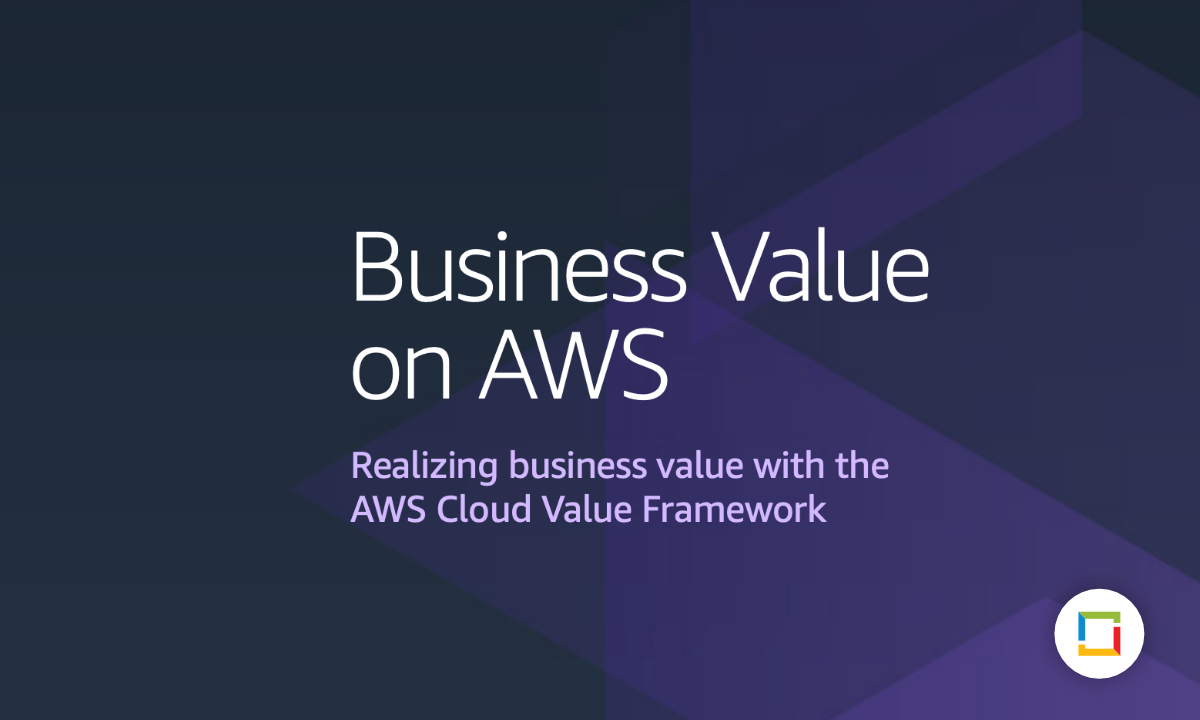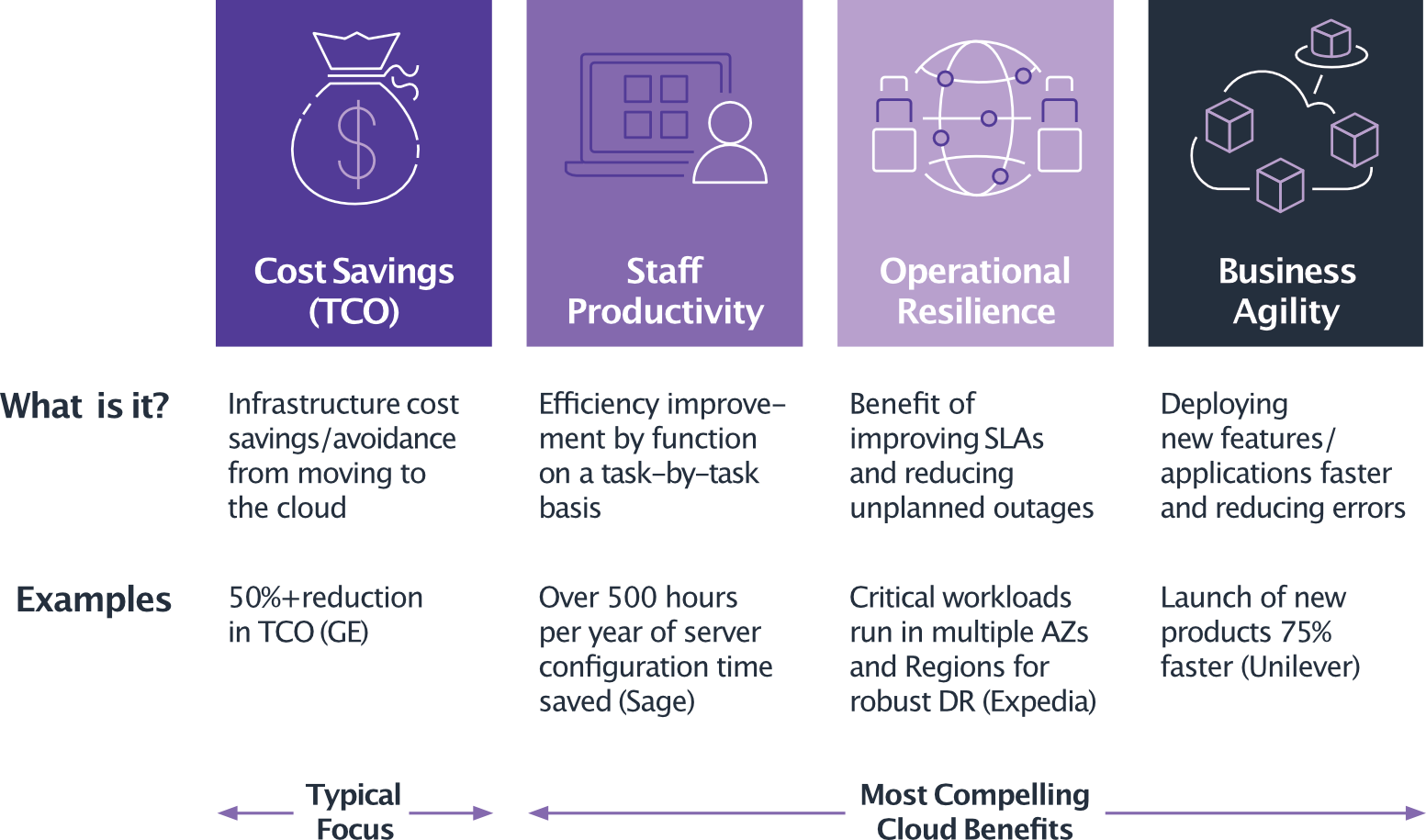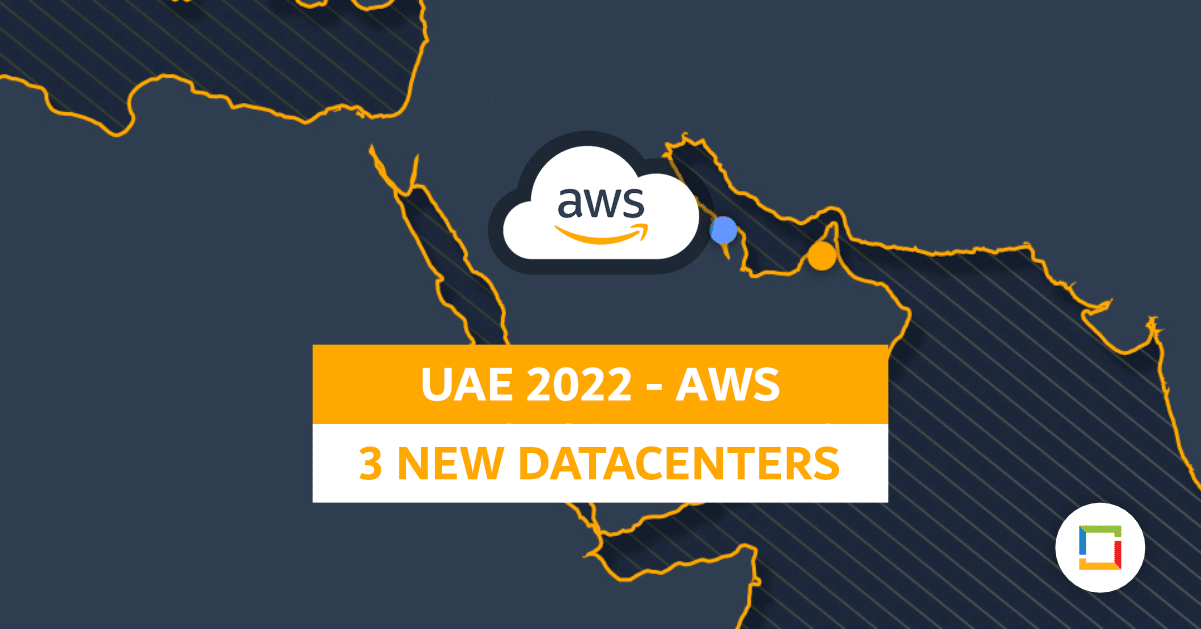The Cloud Value Framework enables organizations to build a comprehensive business case for cloud computing by measuring and tracking progress against four key dimensions of value.
AWS Cloud Economics developed the Cloud Value Framework by working with more than 100 enterprise AWS customers and analyzing over 1,000 public AWS case studies.
The results show four main areas in which AWS customers are realizing business value by moving to cloud computing:
- Cost Savings
- Staff Productivity
- Operational Resilience
- Business Agility
This article provides an overview of how the cloud is transforming business and an analysis of the four aspects of the Cloud Value Framework listed above.
The Cloud Value Framework contains four key pillars
Cost Savings
When it comes to a traditional data center, capacity planning is typically a major challenge. It requires accurately predicting technology needs and procuring equipment typically 6–9 months before it’s operational. Additionally, companies usually provision 20–50 percent over peak requirements to avoid services outages. The Natural Resources Defense Council estimates that average server utilization is only 12–18 percent.1
With the cloud, organizations pay only for what they need. During periods of low usage, they use fewer resources; during periods of peak demand, the system scales to deliver the required performance. Supply and demand are closely matched, eliminating the waste inherent in traditional data center models.
Reducing IT costs associated with owning and managing infrastructure is often the first thing businesses consider when beginning their cloud journey. While each organization is different, cloud cost savings come in two main varieties. First, organizations can save money by not spending it in the first place, avoiding data center–related capex and opex on hardware, software, networking, facilities operations, and upgrades. Because there are typically no minimum commitments required for cloud services, they can stop or start using a service at any time, further increasing cost efficiency.
To maximize cost savings, it is important to build a culture of cost optimization. This means being able to track and manage cloud costs by tagging resources and using AWS tools such as AWS Cost Explorer and AWS Trusted Advisor to identify opportunities to improve utilization and assign responsibility for managing cloud costs. For more information, see the AWS Cost Optimization webpage.
AWS provides pricing models that help organizations save even more money. Using AWS services such as Amazon Elastic Compute Cloud (Amazon EC2) Reserved Instances, organizations can reserve instances upfront and save as much as 75 percent compared to the on-demand price. Amazon EC2 Spot Instances allow organizations to purchase spare computing capacity at up to 90 percent off the on-demand price. And, the more GB stored in or transferred out of AWS, the lower the cost per GB.
Staff Productivity
Another way that customers achieve value with AWS is through increased staff productivity. In the data center world, employees spend a lot of time doing work that doesn’t differentiate the business. For example, previously, a significant proportion of staff might have been dedicated to procuring, setting up, and maintaining physical servers.
With AWS, these responsibilities are reduced or no longer necessary. Organizations can move away from the day-to-day operational headaches associated with managing IT infrastructure. IT expertise can be put to better use doing strategic, differentiating work, such as developing new and improved applications and delivering a better user experience.
The cloud also lends itself to modern software engineering approaches. These include continuous integration/continuous deployment, microservices architecture, automated testing, and blue/green deployments that test application code in a separate environment before moving it to production. Development and test environments can be provisioned and deprovisioned in seconds to meet the evolving needs of a business. This transformation can significantly reduce time-to-market for applications and services. For example, Expedia has migrated and re-architected its travel platform onto AWS, allowing it to now deploy over 2,000 times per day.
Operational Resilience
Unplanned outages due to security breaches, hardware failures, software glitches, or human error can be very expensive. For example, one IDC study – “DevOps and the Cost of Downtime: Fortune 1000 Best Practice Metrics Quantified” – places the average annual cost of downtime for Fortune 1000 companies at $1.25–$2.5 billion per year. A critical application failure can cost $500,000–$1 million per hour. Using cloud services can increase operational resilience and avoid these high costs of IT disruption. There are four key areas in which AWS helps organizations improve operational resilience: infrastructure, operations, security, and software.
First, AWS provides a highly resilient infrastructure to protect against hardware failures, natural disasters, and power outages. Each AWS Availability Zone is redundantly connected to multiple Tier 1 network providers, virtually eliminating the possibility of network outages. Every compute instance is served by two independent power sources, each with utility, UPS, and backup-generator power. These approaches are standard with AWS but would be costly and complex to implement in an on-premises data center.
Second, from an operations perspective, AWS enables organizations to automate error-prone human elements with tools such as AWS CloudFormation and AWS Service Catalog, which enable highly repeatable deployment of proven configurations. It provides system-wide visibility into utilization, performance, and operational metrics to identify and address issues quickly, helping reduce the complexity of operations while improving the ability to meet service level agreements (SLAs) and keep the business running smoothly.
Third, AWS supports high levels of security. Protecting against ever-evolving threats requires constant vigilance, and the cost of a breach can be significant. AWS continuously applies best-of-breed protections to our global infrastructure. AWS automation and tools help to mitigate security risks such as denial-of-service attacks. With AWS Identity and Access Management (AWS IAM), organizations can securely control access to AWS services and resources, eliminating threats created by rogue servers or unauthorized users. With more than 30 certifications and accreditations, AWS provides a foundation for building compliance-ready applications and services.
Finally, AWS provides mechanisms for reducing the likelihood of software issues that could cause outages. Automation of the continuous integration/continuous delivery workflow can be accomplished using services like AWS CodeDeploy and AWS Code Pipeline. For ultimate peace of mind, AWS Managed Services automates common activities such as change requests, monitoring, patch management, security, and backup services, and provides full-lifecycle services to provision, run, and support infrastructure.
Business Agility
The traditional IT model places constraints on innovation. If a team wants to develop a new application or service, it needs to provision resources to do so. This requires additional time and money, slows time-to-market and cuts into innovation budgets. The cost of failure is another potential roadblock. For example, if a company using an on-premises infrastructure tries and fails to launch a new product, it still must support the hardware it purchased for the project.
With the cloud, developers can instantly provision resources and begin writing code. They don’t have to wait to get the budget to deploy a full infrastructure stack just to try something new because the cloud supports a rapid, agile approach to IT that drives competitive advantage. They can avoid costs because they can shut down instances when they are no longer needed.
Simply put, adopting AWS helps business move faster, whether that means getting innovative products to market before competitors, taking advantage of fresh opportunities, quickly expanding to new geographies, accelerating M&A, or increasing the pace of experimentation. In a digital economy, IT is the enabler of all these capabilities.
In a cloud environment, the risk of trying new things is greatly reduced. For example, if an organization can try 20 ideas on inexpensive cloud development and test infrastructure (which can be deployed in minutes on AWS), deploy 10 of them to production, and keep only two of them over the long term, it can do so with only a fraction of the waste that would be incurred attempting to do so with an inflexible on-premises environment. When an initiative takes flight, scaling up infrastructure to meet demand becomes a simple exercise. IDC estimates that using AWS can result in 25 percent higher developer productivity and enable the delivery of 3x as many features compared to on-premises environments.
The cost of failure is also reduced in the cloud. When initiatives fail, as they so often do, that failure is far less costly because organizations can quickly, easily shut down instances.
AWS research supports these findings, showing that AWS customers save an average of 2.5 months in time-to-market when launching new applications on AWS, while also offering 26.4 percent more new features, updates, and fixes per release. Applications moved to AWS receive significantly higher user satisfaction scores on a 10-point scale, rising from 7.0 to 8.8 for employees and from 6.8 to 8.8 for customers.
Conclusion
The cloud is driving innovation for businesses of all shapes and sizes, across different industries and geographies. The cloud increases cost savings, staff productivity, operational resilience, and business agility. All these elements work together to help businesses achieve differentiation, accelerate innovation, and make the most of the talent inside an organization. AWS removes obstacles to digital transformation and enhances the ability of organizations to compete and succeed in a fast-moving business environment.
Looking for an AWS Cloud Partner in Dubai, UAE? Schedule Your Free, No-Obligation 30 Minute AWS Strategy Session Today!



